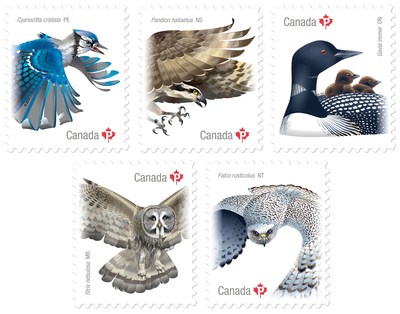Canada Post continued its three-year Birds of Canada series with the release of the second set of stamps on Aug. 1.
Celebrating the diversity of the country’s avian life, the five-stamp issue features provincial and territorial birds from across the country. The birds featured in this latest series include:
- The blue jay (Prince Edward Island) – Often found in their natural habitat of forests across southern Canada, from Alberta to the Atlantic, blue jays are also adapted to many environments, including urban and suburban areas. The blue jay, with its distinctive colouring and largely mysterious migration patterns, can be spotted year-round in Prince Edward Island.
- The Gyrfalcon (Northwest Territories) – The largest falcons in the world, gyrfalcons are fierce predators who typically breed in the Arctic. When hunting, the gyrfalcon approaches its prey at breathtaking speeds, hugging ground contours until it strikes. The gyrfalcon varies in plumage colouring, from pure white, common to those in the high Artic, to dark grey-brown with white streaks.
- The common loon (Ontario) – While clumsy and awkward on their feet, common loons can swim immediately after hatching and are adept at diving under water in search of prey. Commonly associated with the solitude and beauty of Canada’s wilderness, the striking black-and-white feathered birds can be found in rivers and lakes across Ontario, and feature prominently in Indigenous legends.
- The great gray owl (Manitoba) – Great gray owls camouflage themselves in the stillness of Manitoba’s mixed-woods and coniferous forests, and usually hunt near dawn or dusk by listening and watching from a perch. The great gray owl is Canada’s largest owl, and one of the largest in the world, though dense, fluffy plumage make them appear more substantial than they are.
- The osprey (Nova Scotia) – Sometimes mistaken for bald eagles, ospreys are superb at catching fish, which make up 99 percent of their diet. They dramatically plunge into water, plucking fish by locking their talons into them. Located on every continent except Antarctica, one of their primary breeding grounds in Canada is Nova Scotia, where they nest along coastlines and lakes.
STAMP SPECIFICATIONS
The 24 mm by 20 mm stamps are available in booklets of 10 stamps. They were printed by the Canadian Bank Note Co. in six-colour lithography. They were designed by Kosta Tsetsekas, Adrian Horvath and Mike Savage, of Vancouver-based Signals, and illustrated by Keith Martin.
The souvenir sheet of five stamps measures 114 mm x 92 mm and the official first-day cover measures 190 mm x 112 mm. The cancellation site is Yellowknife, N.T.
As with all stamps issued in 2017, a reference to Canada’s sesquicentennial can be found on the stamps. In this case, the Canada 150 logo subtly appears near the birds in a light varnish. David R. Gray, of Grayhound Information Services, provided his valued expertise to this stamp issue.

